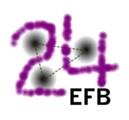Speaker
Description
The three-nucleon force (3NF) is essentially important to clarify various nuclear phenomena, such as the binding energy of light mass nuclei [1], the equation of state of nuclear matter [2] and few-nucleon scattering systems [3]. The isospin $T=3/2$ components of the 3NF also play an important role in many-nucleon systems especially for neutron-rich nuclei as well as neutron matter properties. The $p-^3$He scattering is one of the simplest prove for studying the $T=3/2$ components of the 3NF. With the aim of exploring the properties of the 3NF we are planning the measurement of $^3$He analyzing power for $p-^3$He scattering with the polarized $^3$He target at intermediate energies ($E/A \ge 65~{\rm MeV}$). Polarized $^3$He was produced by the alkali-hybrid spin-exchange optical pumping method. To measure the $^3$He polarization and control $^3$He spin directions, we used the adiabatic fast passage-NMR method. We obtained the absolute value of the $^3$He polarization and calibrated the NMR signal by the electron spin resonance measurement of Rb. The maximum $^3$He polarization was $\sim 50~\%$ in our system.
Using the polarized $^3$He target, we performed the measurement of $^3$He analyzing power at CYRIC ($E_p = 70~{\rm MeV}$) and RCNP ($E_p = 100~{\rm MeV}$) in Japan. Measured angles were $\theta_{\rm lab.} = 35^\circ - 125^\circ$ ($\theta_{\rm c.m.} = 46^\circ - 141^\circ$) at CYRIC and $\theta_{\rm lab.} = 35^\circ - 135^\circ$ ($\theta_{\rm c.m.} = 47^\circ - 149^\circ$) at RCNP respectively. Proton beams were injected to the target, and scattered protons were detected by using $E-\Delta E$ detectors which consisted of plastic and NaI(Tl) scintillators. During the experiment, we measured the $^3$He polarization and flipped the spin directions of $^3$He nucleus by using the AFP-NMR method. We extracted $^3$He analyzing power by measuring the asymmetry of elastically scattered protons from the polarized $^3$He target. In the conference we report recently results of the experimental data.
[1] S. C. Pieper $\it et~al.$, Phys. Rev. C $\bf 64$, 014001 (2001).
[2] A. Akmal $\it et~al.$, Phys. Rev. C $\bf 58$, 1804 (1998).
[3] N. Kalantar-Nayestanaki $\it et~al.$, Rep. Prog. Phys. $\bf 75$, 016301 (2012).
